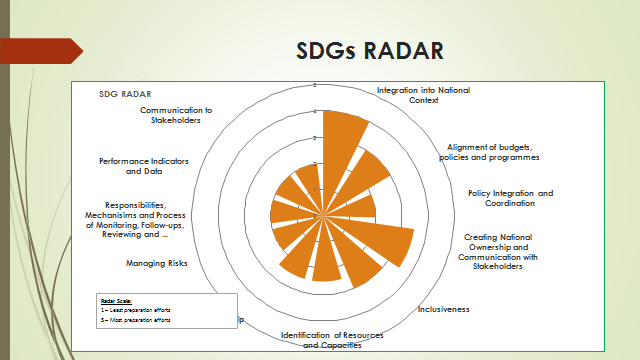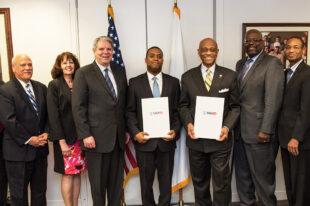Supreme Audit Institutions and the Sustainable Development Goals: Charting the Best Path Forward

Four years ago, 193 nations of the United Nations General Assembly put pen to paper and agreed to sign on to implement 17 Sustainable Development Goals (SDGs). They were ambitious goals, targeted for 2030 and envisioned, among other things, ending poverty and hunger, improving health and education, making cities more sustainable, combating climate change, and protecting oceans and forests.
But for goals to be met, action must follow. How does a country chart its progress? How can citizens be sure a nation’s government follows through on these commitments? This is where a nation’s Supreme Audit Institution (SAI) can play a critical role. Through high-quality audits, SAIs can help governments examine preparedness for implementation and help generate a focus on an integrated, “whole of government” approach.
One segment of the world’s SAIs spent a week laser-like focused on these questions and how best to execute the important roles SAIs can play. The Pacific Association of Supreme Audit Institutions (PASAI) held its annual Congress in Fiji, where member SAIs and development partners shared best practices in what SAIs are already doing, as well as help SAIs chart an effective path forward.
“The role of the SAI in auditing SDGs is critical, and it is our role as PASAI’s Secretariat, to ensure that every SAI is equipped to rise to that challenge,” said Tiofilusi Tiueti, the PASAI Executive Director. “We are already responding to the shifts in learning delivery emphasized by the independent Mid-Term Review at the half-way point of the PASAI 2014-2024 strategy by providing the right support, at the right time, in the right way. With regard to auditing SDGs, the Secretariat will build a learning and knowledge platform for SAIs to provide information and guidance on SDG-related matters, while also sharing SAI successes and ‘more-work-to-do’ SDG stories through its communications network.”
What is a “whole of government” approach? The INTOSAI Development Initiative (IDI) points out a single SDG can impact areas across many different ministries, plans, policies and budgets (horizontal) and across different governance levels (vertical), so a comprehensive approach is required. “Whole of government” is an overarching term for a group of responses to the problem of increased fragmentation of the public sector and public services and a wish to increase integration, coordination and capacity. It has three audit objectives: 1.) To what extent has the government adapted the 2030 agenda into its national context? 2.) Has the government identified and secured resources and capacities (means of implementation) needed to implement the 2030 Agenda? 3.) Has the Government established a mechanism to monitor follow-up, review and report on the progress towards implementing the 2030 Agenda?
The SAIs in PASAI have learned a great deal about performance audits and working on cooperative initiatives and plan to consolidate this learning into the strategic planning processes of their offices. Ten SAIs in the Pacific region are taking part in a Cooperative Audit on Preparedness for the Implementation of the SDGs, five of which have already published audits or submitted them to Parliament.
In Tonga, Auditor General Sefita Tangi developed a compelling visual tool to track that nation’s efforts on implementation. “The SDG radar shows that Tonga has best performed in integrating the SDGs into its national context and least performed in policy integration and coordination; identification of responsibilities, mechanisms, process of monitoring, follow-ups, reviewing and reporting; performance indicators and data, and communicating to stakeholders.”

Neither Tonga, nor any of the SAIs around the world, are facing these SDG audit challenges alone. IDI is supporting SDG implementation, and, in cooperation with the INTOSAI Knowledge Sharing Committee, IDI launched a capacity development program on “Auditing Sustainable Development Goals.”
“IDI envisions effective, accountable, inclusive SAIs making a difference through high-quality audits of SDG implementation,” said Archana Shirsat, Deputy Director at IDI. In fact, IDI is currently developing an audit model—the IDI SDG Audit Model (ISAM)—to help SAIs in auditing SDGs. “The ISAM will support SAIs, across INTOSAI regions, in reflecting on key strategic considerations at the SAI level and in conducting ISSAI compliant audits of SDG implementation,” Shirsat said. “In keeping with SDG principles, ISAM will provide guidance on examining policy coherence, inclusiveness and multi stakeholder engagement in implementing nationally agreed upon targets linked to SDGs.”
PASAI’s Development and Regional Partners are committed to supporting these efforts and have already undertaken significant work in these areas, which can act as an accelerator. Keshwa Reddy, Program manager for Regional Government and Economic Growth for the Australian High Commission, said “development partners are committed to sharing expertise, approaches and lessons learned to help shape SDG advancement in the Pacific.”
As the PASAI Congress wrapped up, the host, Fiji Auditor General Ajay Nand, said he “hoped that the Congress will allow PASAI member countries to share their success stories on audit preparedness, on implementation of SDGs, and also bring to the forum challenges faced for discussion and resolution. In this way, the member countries would be better prepared to carry out the audit of SDG implementation, which is the next phase.”





